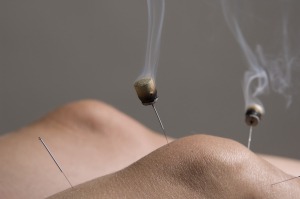Acupuncture for Tennis Elbow, Carpal Tunnel Syndrome, Sports & Soft Tissue Injuries, Repetitive Strain Injuries (RSI)
Home > A-Z of Conditions Treated by an Acupuncturist > Acupuncture for Tennis Elbow, Carpal Tunnel Syndrome, Sports & Soft Tissue Injuries, Repetitive Strain Injuries (RSI)
Sprains, Strains & Inflammation
 Typical soft tissue injuries from sports may include:
Typical soft tissue injuries from sports may include:
- Strain, muscle damage due to overstretching and tearing of muscle fibres
- Sprain, an injury in a joint, caused by the ligament being overstretched
- Contusions or bruises due to damage to small blood vessels which causes bleeding within the tissues.
When soft tissues are damaged, the dead and damaged cells release chemicals which start an inflammatory response.
Inflammation is characterised by pain, localised swelling, heat, redness and a loss of function. Small blood vessels are damaged and cause bleeding in the tissue. A small blood clot forms to stop this bleeding. From this clot cells called fibroblasts initiate the healing process by laying down scar tissue. This inflammatory stage is an important prelude to healing. Unfortunately, sometimes the inflammatory response is excessive resulting in significant discomfort and delayed healing and recovery. Hence, one of the first aims of treatment is to reduce inflammation. The initial inflammatory phase usually lasts about 5 days. PRICE therapy – Protection, Rest, Ice, Compression and Elevation – is recommended to help reduce inflammation during this period. If your symptoms are severe, you may be referred for physiotherapy.
Achilles tendinopathy is a condition affecting the Achilles tendon, which runs between the heel and the calf muscle in the lower leg. It’s thought to be caused by repeated damage to the Achilles tendon that fails to heal properly.
Plantar fasciitis is a condition in which the plantar fascia (a band of tissue in the foot) become damaged and thickens causing heel pain.
You can reduce your risk of sports injuries by warming up before exercise and stretching afterwards. Do not push your body beyond your current fitness level, build up gradually and use the right equipment and techniques. Sports injuries tend to affect the lower limbs.
ABOUT REPETITIVE STRAIN INJURY (RSI)
Repetitive strain injuries (RSI) are a range of conditions in which pain felt in muscles, nerves and tendons is caused by repetitive tasks, overuse, forced exertions, repeated vibrations, mechanical compression, or sustained or awkward positions of the musculoskeletal system. RSI often occurs in those who work on computers or who do repetitive manual work. It most commonly affects parts of the upper body, such as the forearm, elbow, wrist, hands, neck and shoulders. The symptoms can vary, but often include pain or tenderness, tingling or numbness, stiffness or cramp. Risk factors include continuing activity for prolonged periods without rest, poor posture, stress and a cold environment. There are two types of RSI: Type I is when the pain is the result of a specific medical condition, such as tennis elbow or carpal tunnel syndrome. Type II is when no specific cause can be found and is often referred to as ‘non-specific upper limb pain’.
Tennis elbow (lateral epicondylitis) is an acute or chronic inflammation (tendinosis) of the tendons that join the forearm muscles on the outside of the elbow. The forearm muscles and tendons become damaged from repetitive overuse, for example in playing tennis or hedge cutting, leading to inflammation, pain and tenderness on the outside of the elbow.
Golfers elbow (medial epicondylitis) is tendinosis of the medial epicondyle of the elbow. The anterior forearm contains several muscles involved with flexing the fingers, and flexing and pronating the wrist. The tendons of these muscles come together in a common tendinous sheath, which originates from the medial epicondyle of the humerus at the elbow joint. In golfer’s elbow this point of insertion becomes inflamed and tender.
Carpal Tunnel Syndrome – CTS is a condition in which the median nerve is compressed as it travels through the wrist (carpal tunnel) and causes pain, numbness and tingling, particularly in the thumb, index and middle fingers. Symptoms may be worse at night, likely due to the position of the hands during sleep. Risk factors include: diabetes, obesity, pregnancy, hypothyroidism, and a narrow-diameter carpal tunnel. CTS may result from repetitive occupational use of the hand and arm from light or heavy work or from an injury that causes internal scarring or poorly aligned wrist bones. Risk factors include a family history of CTS, pregnancy, diabetes, rheumatoid arthritis and repetitive work.
Effective treatment of RSI first requires identification of the activity which is causing the symptoms and taking steps to modify it. If your symptoms are severe you may need to discontinue the activity. If the aggravating task is work related then you will need to speak to your Occupation Health representative. Conventional treatment of RSI typically includes use of anti-inflammatory pain killers, use of a heat or cold pack, an elastic support or splint, or steroid injections (in severe cases). Other therapies include physiotherapy, massage and yoga.
ACUPUNCTURE FOR SPORTS AND REPETITIVE STRAIN INJURIES
 The World Health Organisation report on acupuncture and clinical trials (2003) states that acupuncture has been proven effective for the treatment of Tennis Elbow and Sprains. Studies also suggest that acupuncture may be helpful in treating tennis elbow, plantar fasciitis and shin splints.
The World Health Organisation report on acupuncture and clinical trials (2003) states that acupuncture has been proven effective for the treatment of Tennis Elbow and Sprains. Studies also suggest that acupuncture may be helpful in treating tennis elbow, plantar fasciitis and shin splints.
Acupuncture may help relieve symptoms of pain and inflammation in sports and repetitive strain injuries by:
- Reducing inflammation
- Stimulating nerve function in muscles and tissues, and releasing endorphins (natural pain relieving substances)
- Delivering analgesia
- Changing pain processing in the brain and spine
- Changing sensory input to the brain
- Reducing muscle stiffness and improving joint mobility by improving circulation which aids reduction in swelling
- Calming sympathetic nervous activity, to promote relaxation and reduce tension
See also:
TREATING SPORTS AND REPETITIVE STRAIN INJURIES – TENNIS ELBOW

“In clinical practice, good results can generally be achieved after a few sessions by treating tennis elbow according to acupuncture meridian theory. Chronic cases tend to take longer, especially if steroid injections have been given.
What is crucially important is that patients refrain from overexertion of the joint for a period to allow the tissues to heal. What often happens is that patients are so pleased that their pain levels have reduced, they assume that ‘it’s all better’ and spend the afternoon pruning the hedge! If the tissues have not yet healed fully, the pain comes back. Acute tendon strains take about 8 weeks to repair and months to years to remodel, so it’s important to be patient if you want to avoid recurring problems in the future.”
FURTHER INFORMATION
Backer, M & Hammes, M (2010). Acupuncture in the Treatment of Pain, An Integrative Approach. Elsevier
Maciocia, G. 2005. The Practice of Chinese Medicine. Painful Obstruction Syndrome. 561-604. Churchill Livingstone
Research Fact Sheets
For more information see the British Acupuncture Council Research Fact Sheet below.
Testimonials
“I initially saw Judy for help with a painful arm which she managed to sort out very quickly. I am now seeing her regularly for facial acupuncture. The results have surpassed my expectations. Friends and family have been commenting on how nice my skin looks and there has definitely been an improvement in the texture and radiance of my skin. The treatment is not at all painful and I actually find it very relaxing. It is a pleasure to visit Judy and she is always happy to answer any questions I might have. Judy is very professional and personable and her treatment room is a lovely warm relaxing environment.”
“Suffering from tennis elbow, I initially sought treatment from my GP. After no apparent improvement a friend recommended acupuncture. It was a great recommendation as I’m now happily back playing racquet sports as before, without pain! The added bonus was that following acupuncture I generally felt much better in myself. As a consequence, I would recommend acupuncture to anyone, and will continue myself to enjoy the benefits of treatment.”



